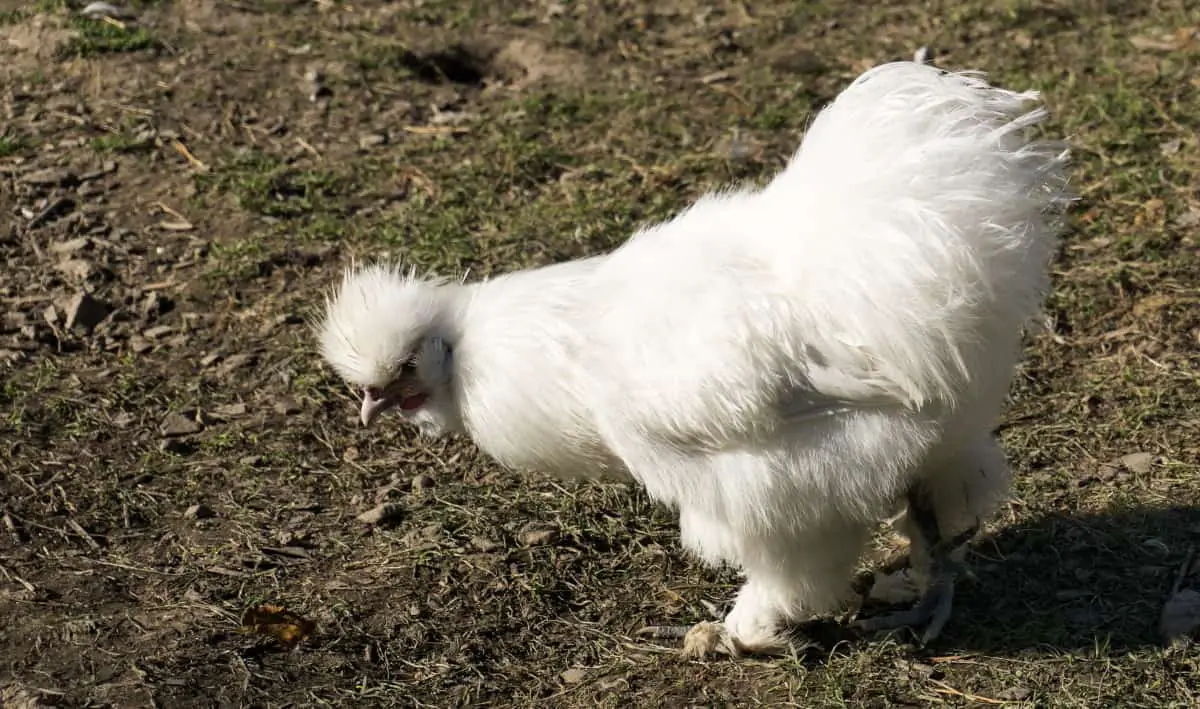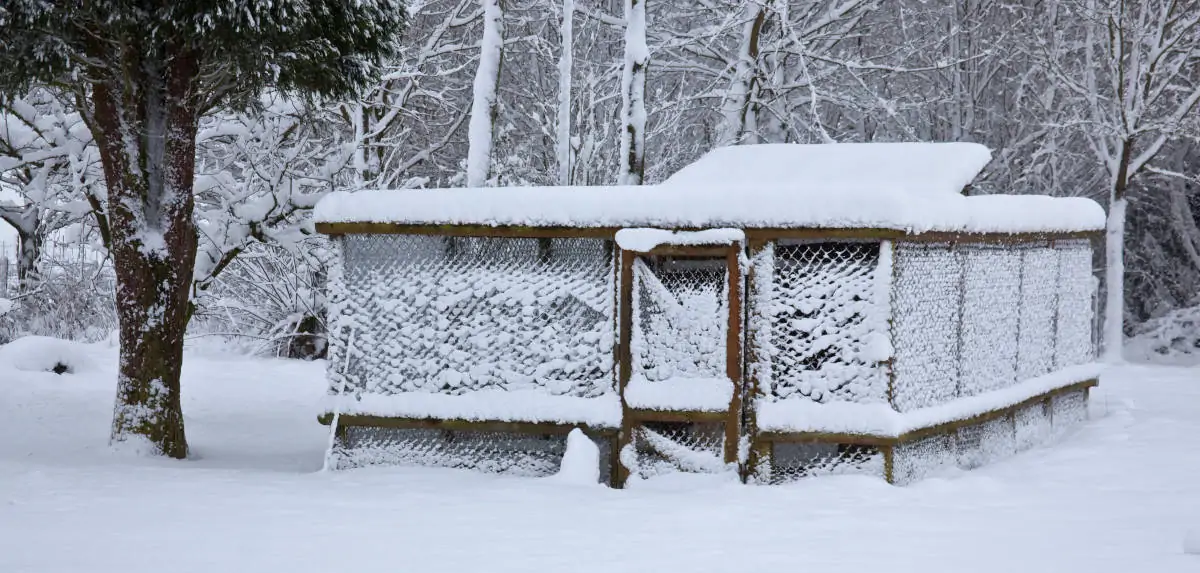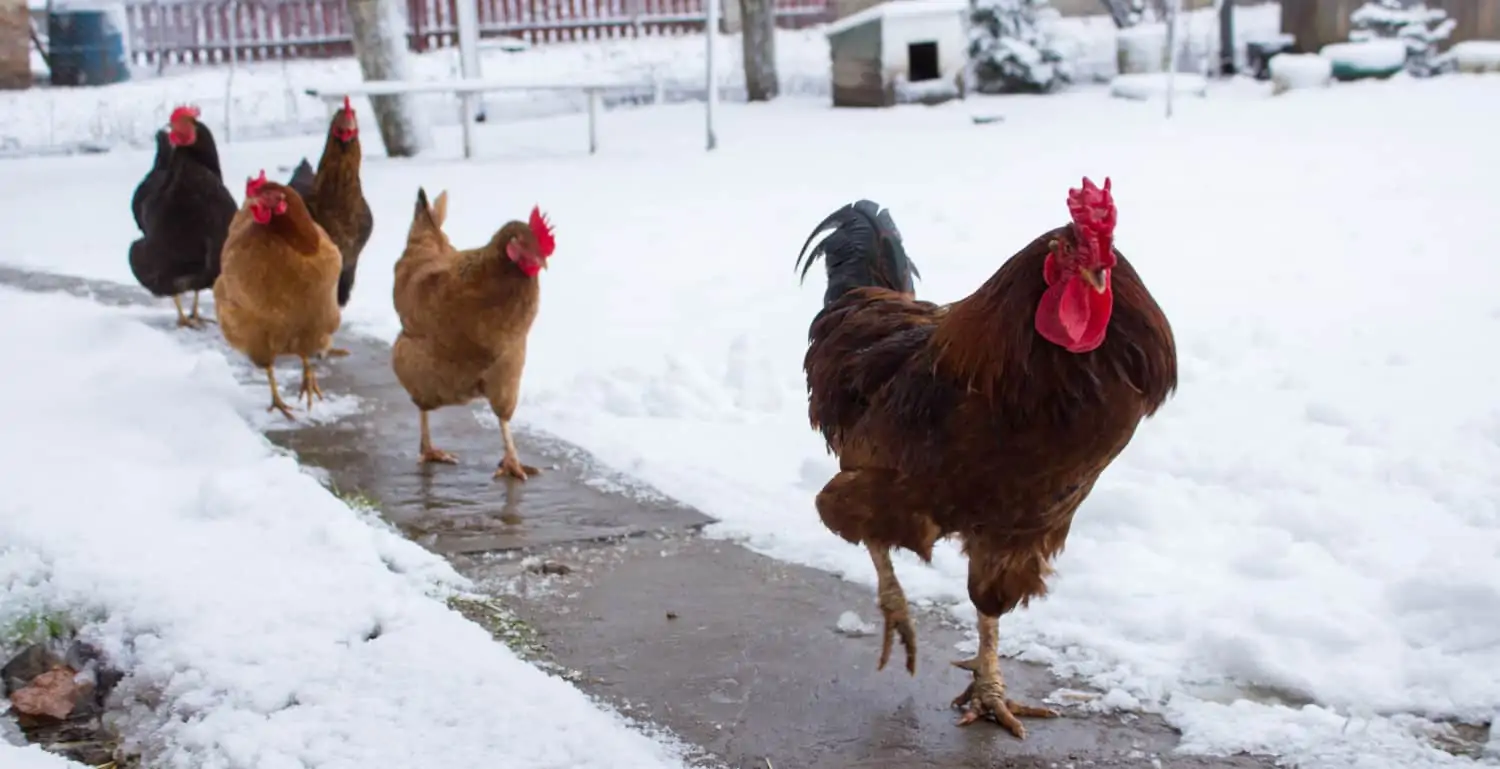“What temperature is too cold for chickens?“, “What is the coldest temperature chickens can survive in?“, “What should you do to keep your chickens warm this winter?” These are just some of the questions that many new chicken owners in colder climates ask themselves.
I remember a winter a few years ago, which I’ve now named The Year of Frozen Chickens. I live in a northern but mostly relatively mild climate, but that winter, it got down to -20°F (-28.9°C) for several days in a row. What was worse, though, is that it didn’t get above -10°F (-23.3°C) for the rest of the month.
It was not an easy month for the chickens or me. What I learned from that experience is that there is such a thing as too cold for chickens, and if the winter weather is going to be this cold, you need to make some preparations beforehand.
In this post, I’m going to be sharing everything you need to know about keeping chickens warm in the winter weather. Including what temperatures chickens can and cannot survive in and what you need to do in order to make sure your chickens are safe and warm this winter.
Table of Contents
What Temperature Is Too Cold for Chickens?
Chickens can survive in any environment where humans can. While a few breeds are more sensitive to cold, 35 degrees Fahrenheit is not a problem for most chickens. At 20 degrees, they may not stay out all day, but they will be okay. Only if it gets colder than -20 degrees inside the coop do you need to take extra precautions to ensure that your chickens are warm enough.
That being said, people successfully raise chickens in very cold climates, such as northern Alaska and Canada, where temperatures can get as low as -60 degrees in the winter. They only need to make a few adjustments in order to ensure their birds are safe and warm during the winter.
Chickens generally prefer cooler temperatures and can handle cold better than heat. Anything above freezing is rarely an issue unless it’s wet or very windy. Chances are that if it’s going to get colder than freezing, your chickens will probably have no issues at all as long as you provide them with a dry and draft-free place. What’s dangerous about the cold is how dampness can quickly cool down their core temperature and make it hard for them to warm up again. And draught can lead to respiratory problems, which can be life-threatening.
Age and Life Stage
Young birds and those in the molting stage may not yet have developed enough feathers, and they can’t keep themselves as warm as the rest of the flock. You may have to take extra steps to help them out.
It Depends on the Breed
Some breeds can better withstand cold temperatures than others, just like some are better adapted for warm climates. Chickens bred for cold climates have more down feathers (the fluffy part at the base of the feather), and some eat more food and have higher metabolisms than others. If you live in a cold climate, it is advisable to research breeds that are well suited to the climate you live in. Here are a few great cold-hardy breeds:
- Orpington
- Australorp
- Rhode Island Red
- Wyandotte
- Welsummer
These breeds are medium to large in size with more fat than other poultry breeds. They have less exposed skin; relatively smaller combs and wattles; and their feathers are very water-resistant. A notable exception is the small Silky chicken, which is also fairly cold-hardy because of its many down feathers. The Icelandic chicken is also a fairly small but incredibly winter-hardy chicken.

Can Chickens Stay Outside in the Winter?
Chickens not only can but should be outside during the winter. Or at least, they should have the opportunity to go outside during the day. This is because they require fresh air and sunlight to stay healthy. Restricting them from going outside can lead to illness and other health problems.
On most winter days, you can easily let your birds out, including days with snow. However, they should always be given access to shelter (their coop), which provides protection from the elements. As long as they have a dry and clean shelter, there is no reason why you cannot let your chickens outside all year round.
Most chickens have a good sense of when it’s too cold to go outside. Not only do different breeds react differently to cold, but each chicken also has their own preferences. If given a chance, some chickens will keep foraging during the coldest winter days, while others won’t leave the chicken coop at all. Some will rest or nest in trees around them, but you want to give them the option to come in if they need it.
Always bring them home before leaving your home to ensure their safety if the weather turns nasty.
Most chickens dislike walking in the snow. While most breeds can keep their body warm in very cold weather, their legs and feet often freeze, and the risk of frostbite should not be ignored. If there is snow in the run, you may want to clear it out, or you can use bedding materials such as straw and wood shavings. If snow is a common occurrence in your region, it’s a good idea to cover the run partially or entirely with a roof. Use transparent materials to let in sunlight.
How to Tell If My Chickens Are Too Cold?
When chickens are chilly, they fluff up their feathers, and they might appear listless. Often, they will stand on one foot with the other tucked up against their body – changing legs every once in a while. Their combs and wattles will also be pale in color instead of bright red as a healthy chicken comb would be.
Chickens’ downy coat helps them maintain a consistent body temperature during the winter. A healthy flock will not remain in the coop unless the weather is really bad but spend most of the day foraging for food and staying active. If they stay in there all day, the weather is probably too cold for their taste.
What to do when your chickens start to freeze?
If your chickens show signs of being cold, you should take steps to correct the situation. To keep heat in, close the coop door for the day. A heat lamp may be used to keep your chickens warm during the worst cold spells, but keep in mind that it can pose a fire hazard.
Keep an eye on your hens on cold days for signs of hyperthermia. If a chicken is at risk of hypothermia, you can tuck her inside the collar next to your body and bring her inside your home. You can heat towels in the dryer on the hottest setting before you wrap your chicken in the towel. When she gets more lively and starts eating again, you can transfer her back to the coop.
Guard Against Frostbite
Chickens with large wattles and combs can develop frostbite, even if their body temperature is normal. This happens when the tissue is exposed to so much cold that it freezes and dies. Frostbite will usually not kill the chicken but is undoubtedly very painful, and it is an indication that she may be at risk of hyperthermia. Eventually, the damaged area will fall off and not regenerate. Chickens can also get frostbite on their feet and toes – especially if they are walking in snow or water.
If the color on the combs becomes very pale during cold months, you will need to treat your birds and protect them from the colder temperatures. Otherwise, the exposed skin might turn black or grey due to frostbite. This is one reason why chicken breeds with smaller combs and wattles tend to be better at handling cold weather than breeds with larger combs and wattles.
If you see signs of frostbite, immediately move your bird to a warm area and provide extra warmth. Here is a great article on How to Help Chickens with Frostbite. If the frostbite is severe, you should seek a veterinarian’s help.
Feeding Chickens In the Winter
In the cold, your chickens require a considerable amount of energy to stay warm. Their food requirements increase by about 50%, and they will need lots of proteins and carbon-rich foods to stay warm. You should keep the feeder topped off throughout the winter, and be sure to include more scratch than usual in their diet.
Give Your Birds More Protein and Carbohydrate
Stick to your usual feed but supplement with barley, oats, corn, or wheat to increase protein consumption. I suggest giving cracked corn to your birds late in the day because digesting corn warms your birds and keeps them full for a longer period. For protein, you can provide any (cooked) meat scraps, but mealworms are also a good option.
On particularly cold days, your chickens will love a warm portion of oatmeal mixed with seeds and fruits. Fruits such as apples, bananas, and melons provide many beneficial nutrients. Just avoid added salt and processed sugar.
Ensure Adequate Water
In the cold season, your hens will drink less because they don’t have to keep their bodies cool; nevertheless, they still need access to fresh water. Chickens do not need heated water – they can drink it even if it is freezing cold as long as it is liquid. Placing the waterer inside the coop may be enough to keep it from freezing, but it may also increase humidity levels.
If there is power, I suggest using a heated base to keep the water liquid during the coldest days/nights. This is the easiest and most convenient way to ensure your chickens have access to water at all times.
A more low-tech method is to keep the water in a tub and place ping pong balls in the water. The balls will keep the water moving and increase the time it takes for water to freeze over. In very cold weather, this will not be enough to prevent the water from freezing, so you may have to pour boiling water into the tub once in a while.
Preparing for Cold Weather: How do I keep My Chickens Warm?
Chickens can tolerate subfreezing temperatures, but keeping them reasonably warm throughout the winter will help them keep healthy all season long. Watch your poultry throughout the day, and check up on them during particularly cold nights.
The birds need a well-ventilated coop. Cover the floor with hay or sawdust, provide heat sources in extreme cold and make the floor as dry as possible. A wet floor increases the chance of hyperthermia and frostbite.
Eliminate Drafts and Keeps Your Hens Dry
Chickens are messy birds. They will bring snow into the coop, spill water on the bedding, and track in mud on their feet. This will all lead to increased humidity which can lead to mold, colds, and pneumonia, and other respiratory problems. If they’re wet, their ability to keep warm will be greatly reduced.
Keep the floor dry and clean by removing wet spots daily or as often as possible. Change bedding when necessary to keep the coop as clean and dry as possible. The coop needs ventilation, but the cold air shouldn’t blow directly onto the birds. Vents should be placed under the ceiling to let damp air escape. If your coop is drafty, you should cover the openings with cloth, plastic, or other material. If the weather is severe, you can use tarps to cover the coop’s sides.
Should You Insulate the Chicken Coop?
In most locations, insulating the coop is unnecessary. As long as it provides cover from wind and wet weather, your birds can usually survive without insulation. However, insulating your coop might be a good idea if you are in an extremely cold region.
In most cases, it’s better to spend the money on a heat source that can be placed inside the coop when needed. It’s easier and often more economical to heat the coop for a few days a year instead of insulating the entire space.
If insulating the coop is a must, you can use most types of insulating materials, but make sure it is inaccessible to the birds. If the chickens peck at it, they may puncture holes in it and consume it, which can lead to serious health issues. Also, install a vapor barrier on the inner surface. If the insulation becomes wet, it may lose its effectiveness and develop mold.
Try Deep Litter
Deep litter is a technique that allows bedding material and chicken manure to build up in layers over longer periods of time. Essentially, you are composting the bedding and manure inside the coop. This speeds up the composting process during winter and creates heat which can help your chickens stay warm. And by the spring, you will have lots of nicely composted material for your garden.
Here’s how to do the deep litter system in your chicken coop:
- Clean the coop and put down about 5 inches of compressed bedding.
- Once a week, turn the litter with a pitchfork and add about 5 inches of fresh material to the top. As you add more litter over time, it will compress down and create layers of composting manure that heats up as it decomposes. Remember to clean the perches still and replace dirty bedding in nesting boxes.
- After about six months, you can remove all the composted litter, which will be nicely decomposed by then.
The deep litter method is a useful method for those who own a larger coop with concrete or other non-organic floorings. I do not recommend it for small coops or coops with a wooden floor. In small coops, it can be hard to manage humidity without replacing the bedding frequently, and wooden floors will rot.
Offer an Indoor Dust Bath
Dust bathing is not just for the summer. To keep their feathers clean and avoid parasites, chickens must dust bathe all year. This is also important during the winter since it distributes the oil on the feathers, which helps insulate the hen from cold temperatures.
During the summer, there are probably lots of patches of dry, loose dirt in your chicken coop that your chickens can use for dust bathing. In the winter, the ground is frozen and wet or covered in snow, so you may have to help them out by bringing a container of sand and loose dirt into the coop. Many people use a plastic kiddie pool for this purpose, but any shallow container will do.

Use Artificial Light If You Live up North
The farther north you reside, the shorter the days are in the winter. And just like humans, chickens can get depressed when subjected to long periods of darkness. To help your flock stay happy and healthy, hang a light inside the coop. This extends the day and keeps your hens active.
Light also stimulates the release of a hormone called prolactin which controls reproduction as well as molting. This speeds up their transition from winter into springtime breeding mode. In other words, it keeps your egg production going all winter long.
You can use regular incandescent bulbs for this purpose, or you can consider using a light that simulates natural sunlight, like the ones sold for growing plants indoors. Be careful of fire hazards!
Some people use a timer to regulate how long the light stays on. I recommend turning the light on in the morning and letting the natural sunlight end the day. To settle on the roosts, your birds require a gradual decrease in daylight. If the lights turn off too suddenly, they will not be able to see the roosts.
Should I Add Heat to My Chicken Coop?
In most cases, you should avoid using a heater. Chickens don’t need heating because they stay warm by huddling together during colder nights. A well-ventilated coop free of draft and plenty of bedding are the only things your birds need to stay warm. If it’s below -10 degrees, don’t worry about heating the coop.
If your coop is very cool and your chickens show signs of being cold (listlessness, pale comb, and wattles), you may consider using a small heater. However, this must be done cautiously to avoid fires and other hazards. Be sure to use a heater that is safe for indoor use and never plug it into an extension cord inside the coop. Add something like a small oil-fired radiator (secured in place) or other product that doesn’t get too hot to the touch and without moving parts. Never use a space heater or any type of open flame inside the coop!
You can also construct your chicken coop in a well-lit area to optimize the power of the sun for a free heat source. This will help the coop to remain warm (enough) during the day. You can also install smaller south-facing windows to let the sun in. Large windows, on the other hand, will allow more cold to enter during the night.
What about Sick or Injured Chickens and Cold Weather?
Chickens that are sick or injured need extra care when winter hits. Birds that are injured should never be allowed to remain with the entire flock since they are vulnerable to pecking, even more so during the winter months where chickens can get a little more aggressive due to boredom.
A chicken that is ill or injured is also less able to maintain its body heat. Take extra measures to keep them warm and dry, especially if you live in dark, cold climates with lots of snow. Check them frequently to ensure they are dry and clean. A heat lamp should be provided if needed.
Conclusion
The winter weather can be hard on even the most hearty of people. What about chickens?
The first thing to remember is that even very cold temperatures are not a huge deal for most chickens. Chickens are very good at maintaining their body heat without any special accommodations as long as they have a dry coop with bedding or straw. What they do need is a little extra food to help them keep warm.
How cold is too cold for chickens? It’s different for each chicken and, of course, changes with the exposure time, humidity levels, and wind speeds, but most breeds are capable of handling temps down to -20 C. What you should watch out for are frostbite on combs, wattles, and feet.
It’s important to remember, though, that some breeds are better suited for colder climates. If your hens display indications of being chilly, you may consider using a small heater or heat lamp to keep them warm. Besides, it’s always better to err on the side of caution.


